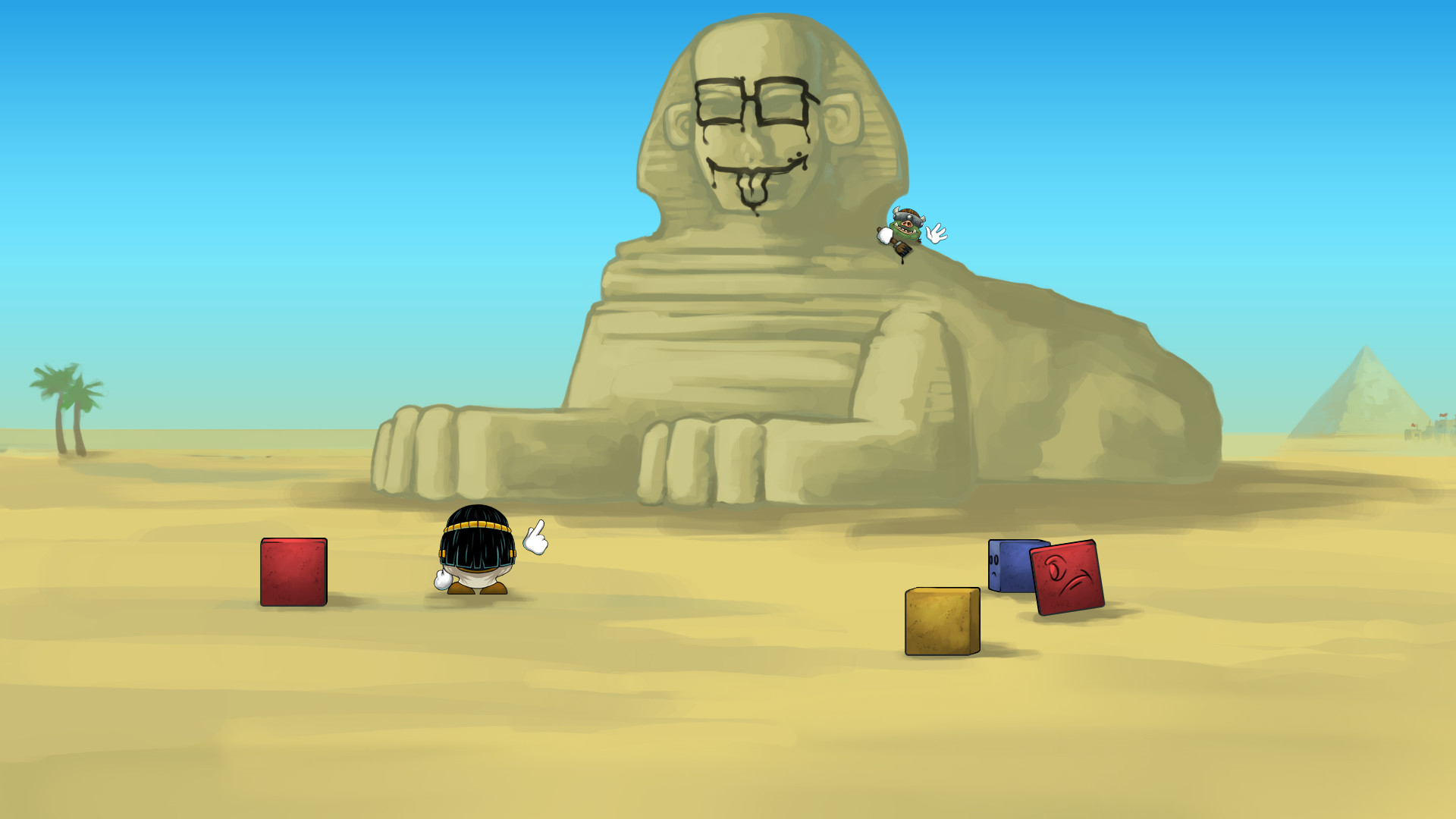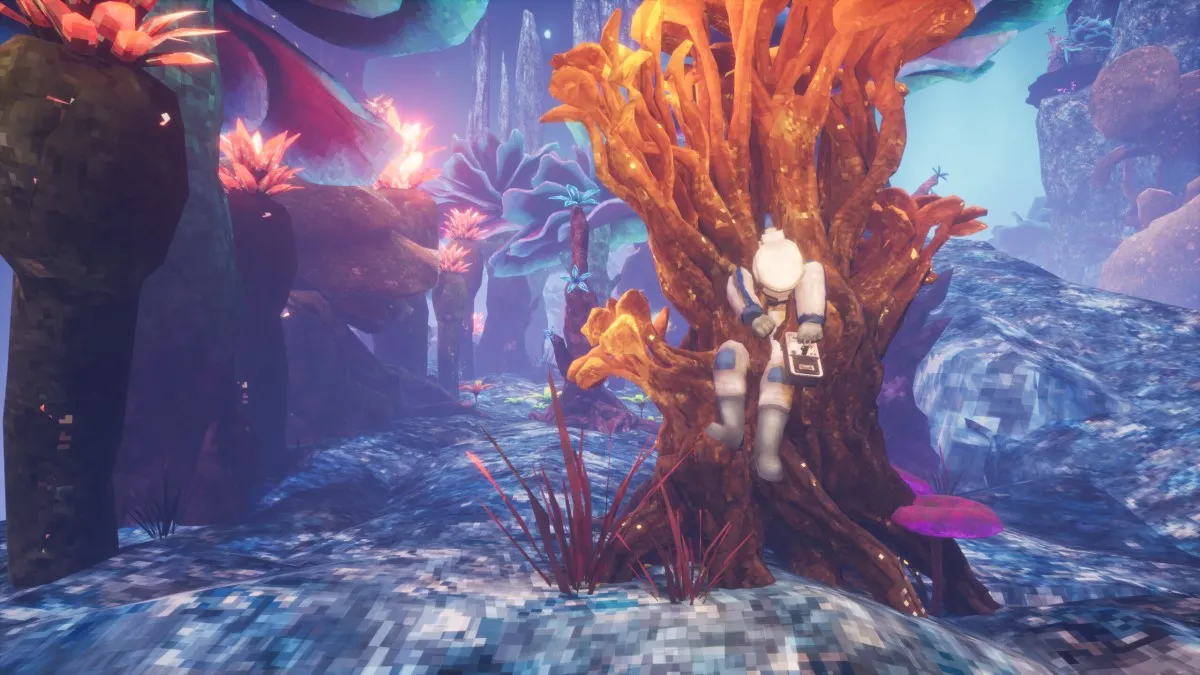My brain hurts…
I can’t think of the last puzzle game that had a color/shape-matching mechanic that I’ve genuinely enjoyed. It might be none of them, actually. I just never felt satisfied after completing a puzzle. I’m more of a candy eater than a candy crusher and more of a bedazzler instead of a bejeweller.
And then there’s Tumblestone.

Tumblestone (PC [reviewed], PS4, Wii U, Xbox One)
Developer: The Quantum Astrophysicists Guild
Publisher: The Quantum Astrophysicists Guild
Released: July 12 (PC, PS4, Wii U), July 16 (Xbox One)
MSRP: $24.99, $9.99 (Multiplayer Starter Pack, PC only)
Tumblestone’s gameplay is very easy to comprehend. Players control a little avatar at the bottom of a stack of blocks, which are the titular tumblestones. The objective is always to eliminate all of the blocks and to do so, players must match three of the same colored blocks at a time. It isn’t a “match three” game in the same vein as Bejeweled or Pokémon Shuffle, since there is no swapping positions of any of the blocks. Every puzzle has a set path or two to take, and mistakes can make it unsolvable, forcing a restart.
Traditional match-three games always end up leaving me unfulfilled; I never get a sense of accomplishment when I finish a tough level. Generally, I feel more like I got lucky this time and likely couldn’t repeat my performance if I needed to. This is most certainly not true in Tumblestone. When playing, I’ll actually know why the moves I made worked. There truly is a sense of satisfaction when completing a particularly hard puzzle, and it feels great. And don’t worry, there are a lot of puzzles.
The game includes a single-player story mode with approximately one bazillion puzzles. Okay, exaggeration aside, there are still over 350 puzzles in story mode — 12 worlds of 30 puzzles each. The story mode actually does have a plot, too. Brief, still-image cutscenes with written dialogue take place at certain moments between levels. The story is quirky and harmless, with plenty of hits and misses in terms of humor.
Most worlds in the story mode introduce a new modifier into the mix. For example, the second world inserts a steel block in the middle row which disappears every other move. These modifiers work to keep the puzzles interesting, thankfully, so that by puzzle 300, players aren’t going insane. That being said, I do wish each world were abbreviated a bit. These puzzles get difficult real fast, and it can be discouraging to struggle with puzzle 11 of 30, knowing that there are so many more that are usually iterating on the same mechanic. The later worlds do mix in multiple modifiers at once to truly test the player’s skill, but it’s easy for mental fatigue to set in.
Players earn skip tokens that can be used to completely ignore a level, but they are few and far between. In order to unlock the modifiers for use in single-player mode, the entire world must be completed. This means that in order to have free access to the modifier list, players will have to complete every single level, many of which are incredibly challenging. It’s a lot to tackle just to unlock modifiers in the arcade mode. I wouldn’t be surprised if some people never experience all of the modifiers this way.
The modifiers themselves are great. There are 11 of varying insanity. Some, like Shot Blockers, are simple to understand and subvert. Another, Column Flip, will completely flip the column that contains the block used to complete a triplet. This turns the traditional strategy on its head, since players must now look at which column they need to end on in order to continue creating color trios. The true beauty is when multiple modifiers are in play. Up to three can be active at a time and, depending on the selection, certain puzzles can be very mentally taxing.

There are also more traditional single-player options via the Arcade Mode. The three available modes are Heartbeat, Marathon, and Infinipuzzle. Heartbeat is an intense race to clear blocks against a constantly-growing puzzle. If players can’t keep up, they get smushed. Personally, this is my favorite mode of the bunch. It rewards quick thinking and deduction and slowly starts throwing in more colors and wildcards to mix things up.
Marathon and Infinipuzzle are geared towards players who are in it for the long run. Marathon puts up a glass panel over most of the puzzle. It’s see-through, but removing a block from behind the class will add a row to the puzzle. If you clear everything not covered by glass, the panel moves down a row. You might win if the glass panel gets pushed off the board, but I’ve never even come close. Infinipuzzle is just that — a puzzle that goes on for infinity. It is possible to lose though if you make too many mistakes.
There is plenty of single-player content here, that’s for sure. The story mode will take dozens of hours, to the point where the sheer breadth of puzzles can feel hopelessly overwhelming. The arcade modes have leaderboards, helping to give some incentive to return to them and get better. Plus, the core gameplay is so solid that it’s always rewarding to create your own challenges and try to complete them.

For many, myself included, the biggest draw of Tumblestone will be the multiplayer. Luckily, there is a “Party Mode” option that unlocks all modifiers and characters (which have no real impact, just cosmetic) for multiplayer play. This locks out achievements and other progress, but is nevertheless an amazing addition.
Competing against real humans feels like a true match of wits and execution. The game is so simple at a surface level that I would spend about two minutes explaining the core mechanics before jumping straight into it for hours. As great as it feels to encounter and overcome challenges in the single-player, it feels even better to experience those challenges as a group while competing to jump over the same hurdles. Online multiplayer is also available, though on PC I have never been able to be matched up against someone online, as the player base seems to be low.
There are three different multiplayer modes: Battle, Tug of War, and Puzzle Race. Battle mode constantly adds more blocks to the puzzle and players must remove colors quickly in order to remain alive. Battle is great for some quick-thinking rounds that don’t last too long and create intense moments between players as both of them are on the verge of getting crushed, since removing blocks sends more blocks to your opponents. Puzzle Race gives everyone the same puzzle and the winner is the player who can solve it the fastest. Tug of War is similar to Battle, but relies on smaller sections of puzzle and is slower-paced. Rounds in Tug of War tend to go the quickest and it is definitely the least interesting of the three modes.

I highly recommend playing local multiplayer with the “same puzzle” option checked. This way, every player has the same exact puzzle in front of them and has the same exact struggles. I also recommend turning on random modifiers, so that every has a new assortment of curveballs. Hearing someone should “Shit! I messed up!” or “Fuck those blues!” only adds to the excitement. And, chances are, you’ll be encountering the same problems in about ten seconds. It’s a blast.
It’s also possible to play offline with bots of varying difficulty. Let me tell you, the more advanced bots are no joke. Sometimes I’ll boot up the game just to challenge the harder bots with certain modifiers on. Inviting friends is also an option, and the game definitely has everyone covered in that regard. On PC it’s possible to generate a Steam code to give out to friends from the main menu. It’s not the full game, but for those who need someone to play with online, it’s one way to handle it.
If you are at all a fan of puzzle games, play Tumblestone. Its intelligent spin on a simple mechanic forces players to plan ahead and think about the consequences of their actions. There is a veritable ton of single-player content, which unfortunately must be completed in order to unlock the rule-changing modifiers for use in the game’s arcade mode. It truly shines when playing with friends in the same room as you all shout expletives while simultaneously thinking that the winner must be a complete genius.
[This review is based on a retail build of the game provided by the publisher.]





